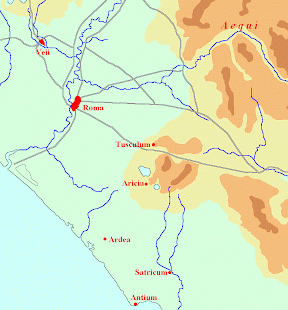Aequi
Q381053Aequi: ancient people, originally living in the western Apennines. Migrating to eastern Latium, they became one of the four main enemies of archaic Rome.

In the course of the Iron Age, the people of Central Italy, who had been living in hilltop settlements, increasingly started to live in larger groups, often consisting of several older settlements. In the coastal area, with access to the sea and easy roads on the plains, this process culminated in the growth of real cities, like Antium, Satricum, archaic Rome, Praeneste, Veii, and Caere. In the hilly interior, this process was a bit slower, but larger political units were created as well, which are often, for lack of anything better, labeled as "tribal". From north to south, we can discern four people: the Sabines in the valley of the river Tiber, the Aequi, the Hernici in the valley of the Tolerus (or Trerus) River (modern Sacco), and the Volsci.
The powerful kings of Rome (e.g, Tarquin the Proud) were able to keep those tribes away, but after the collapse of the Roman monarchy in the final decade of the sixth century, the Aequi and Volsci started to migrate to the plains. While the Volsci are often mentioned in southern Latium, the Aequi managed to expand their power from their homeland in the upper valley of the Anio, to the west. They seized political control of eastern Latium, including towns like Praeneste, Probably, Aequian chieftains seized control in towns that had once been governed by Latin leaders.
In the first half of the fifth century, there were several conflict with the early republic of Rome, in which the Aequi received support from the Volsci, who spoke a related Umbro-Oscian language. The Romans allied themselves to the Latins (Foedus Cassianum) and Hernici. In the second half of the fifth century, the conflict became less violent.
However, after the Gauls had captured Rome in 387 or 386 BCE (390 Varronian), the Aequi tried to recover their influence. They were defeated by Roman commander Marcus Furius Camillus. In the Second Samnite War, they were finally defeated and their towns, still pretty small compared to those of Latium, became part of the system of the Roman Republic. The construction of the Via Valeria through their homeland must have marked the final end of the Aequi.